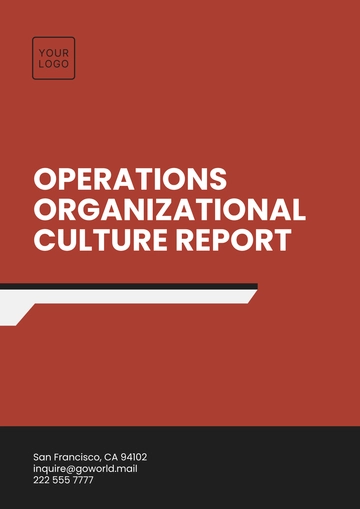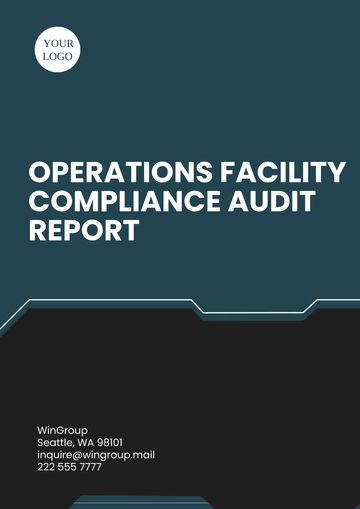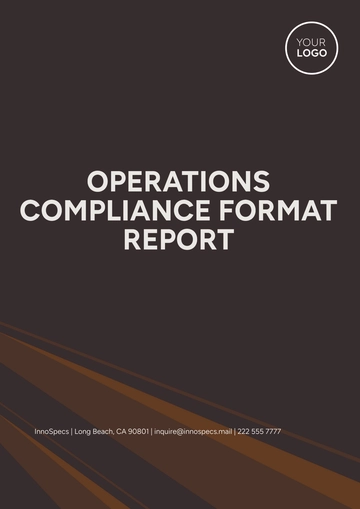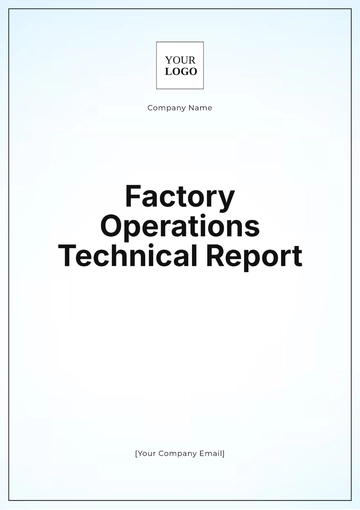Free Operations Facility Compliance Audit Report

[Your Company Name]
[Your Company Email]
I. Executive Summary
A recent audit at [Your Company Name] evaluated compliance with health and safety regulations. The plant mostly met safety protocols, ensuring employee protection, but concerns were noted in PPE usage and safety training. In view of the identified areas of concern, certain recommendations have been proposed. The implementation of these recommendations is expected to enhance the overall safety within the workplace. These suggested measures would not only ensure better utilization of Personal Protective Equipment by the employees but also emphasize improved training regarding its proper usage. The ultimate aim of these recommendations is to reduce the risk of accidents within the workplace, thereby fostering a safe and protected environment for all employees at the [Your Company Name].
II. Introduction
[Your Company Name] operates at [Your Company Address] and specializes in manufacturing automotive components. Our company comprises the machining, assembly, and quality control departments. A recent audit was conducted to ensure compliance with OSHA and internal safety regulations, examining all departments to improve safety and health practices and address potential workplace hazards.
III. Regulatory Framework and Standards
The facility in question is required to comply with various rules, regulations, and standards put into place by various entities, which are specifically focused on maintaining and improving safety in the workplace. These regulations and standards encompass areas such as:
OSHA General Industry Standards (29 CFR 1910)
OSHA Hazard Communication Standard (29 CFR 1910.1200)
[Your Company Name] Safety Manual
These regulations outline requirements for hazard identification, safety training, personal protective equipment (PPE), emergency preparedness, and other aspects of workplace safety.
IV. Audit Findings
Aspect | Compliance Status | Observations |
|---|---|---|
Personal Protective Equipment (PPE) | Partially Compliant | - Inconsistent PPE usage observed across multiple departments. |
Machine Guarding | Non-Compliant | - Missing or inadequately installed guards on high-risk machinery, including drill presses and conveyor systems. |
Hazard Communication | Partially Compliant | - Safety Data Sheets (SDS) are not readily accessible in all departments. |
Emergency Procedures | Partially Compliant | - Emergency evacuation maps not updated to reflect recent layout changes. |
Training and Education | Non-Compliant | - Lack of structured and mandatory safety training for new hires. |
V. Analysis of Non-Compliance
The failure to comply with the use of Personal Protective Equipment (PPE) as well as with training requirements that are in place contributes to a significantly higher risk of injuries and accidents happening within the workplace. Adding to this risk potential is the inconsistent enforcement of safety protocols. This inconsistency, coupled with a lack of adequate record-keeping for training activities, clearly indicates that there are weaknesses within the safety management system of the facility. It's critical for the overall improvement of safety within the workplace that these specific issues be promptly and effectively addressed. By doing so, the likelihood of violations of regulations and potential employee injuries can be significantly reduced.
VI. Recommendations
The following recommendations, which are based on the findings from the audit, are proposed to address any areas of non-compliance that have been identified. Additionally, these recommendations are designed to strengthen the health and safety program currently in place at the facility:
Undertake an exhaustive analysis of the requirements of Personal Protective Equipment (PPE) for all jobs and tasks within the organization. This is to ensure that everyone is in understanding and agreement about the appropriate usage of PPE. Following this analysis, it is of utmost importance to enforce consistent use of PPE across all departments, to maintain not only the safety standards set but also to encourage adherence to these regulations.
The company should enforce a mandatory training program for all employees, including new hires, focusing on essential safety protocols, hazard identification, and emergency procedures to ensure a secure workplace and effective emergency response.
Improve employee training records by creating training matrices and establishing clear record-keeping procedures for better structure and management.
Make an effort to improve conveying safety rules and protocols by organizing regular meetings entirely focused on safety issues, displaying relevant information on bulletin boards that are easily accessible to everyone, and making ample use of electronic communication channels such as emails and online platforms to reach a wider audience.
It is necessary to carry out audits and inspections on a regular basis. This is crucial for monitoring whether or not safety regulations are being adhered to. Additionally, it is important to identify any areas that can be further improved continuously, in order to achieve a higher level of safety and compliance.
VII. Conclusion
During the comprehensive audit, [Your Company Name] showed reasonable compliance with essential health and safety regulations. While the audit confirmed general adherence, some areas need significant improvement. These issues have been identified and flagged, and implementing the recommended actions will enhance workplace safety, protect employees, and ensure ongoing regulatory compliance.
- 100% Customizable, free editor
- Access 1 Million+ Templates, photo’s & graphics
- Download or share as a template
- Click and replace photos, graphics, text, backgrounds
- Resize, crop, AI write & more
- Access advanced editor
Discover the ultimate solution for comprehensive operations facility compliance audits with our editable template from Template.net. Tailored for your convenience, this customizable report template streamlines your audit process effortlessly. Crafted with precision and enhanced by our AI Editor Tool, ensure thoroughness and accuracy in every audit report, making compliance management a breeze.
You may also like
- Sales Report
- Daily Report
- Project Report
- Business Report
- Weekly Report
- Incident Report
- Annual Report
- Report Layout
- Report Design
- Progress Report
- Marketing Report
- Company Report
- Monthly Report
- Audit Report
- Status Report
- School Report
- Reports Hr
- Management Report
- Project Status Report
- Handover Report
- Health And Safety Report
- Restaurant Report
- Construction Report
- Research Report
- Evaluation Report
- Investigation Report
- Employee Report
- Advertising Report
- Weekly Status Report
- Project Management Report
- Finance Report
- Service Report
- Technical Report
- Meeting Report
- Quarterly Report
- Inspection Report
- Medical Report
- Test Report
- Summary Report
- Inventory Report
- Valuation Report
- Operations Report
- Payroll Report
- Training Report
- Job Report
- Case Report
- Performance Report
- Board Report
- Internal Audit Report
- Student Report
- Monthly Management Report
- Small Business Report
- Accident Report
- Call Center Report
- Activity Report
- IT and Software Report
- Internship Report
- Visit Report
- Product Report
- Book Report
- Property Report
- Recruitment Report
- University Report
- Event Report
- SEO Report
- Conference Report
- Narrative Report
- Nursing Home Report
- Preschool Report
- Call Report
- Customer Report
- Employee Incident Report
- Accomplishment Report
- Social Media Report
- Work From Home Report
- Security Report
- Damage Report
- Quality Report
- Internal Report
- Nurse Report
- Real Estate Report
- Hotel Report
- Equipment Report
- Credit Report
- Field Report
- Non Profit Report
- Maintenance Report
- News Report
- Survey Report
- Executive Report
- Law Firm Report
- Advertising Agency Report
- Interior Design Report
- Travel Agency Report
- Stock Report
- Salon Report
- Bug Report
- Workplace Report
- Action Report
- Investor Report
- Cleaning Services Report
- Consulting Report
- Freelancer Report
- Site Visit Report
- Trip Report
- Classroom Observation Report
- Vehicle Report
- Final Report
- Software Report





























